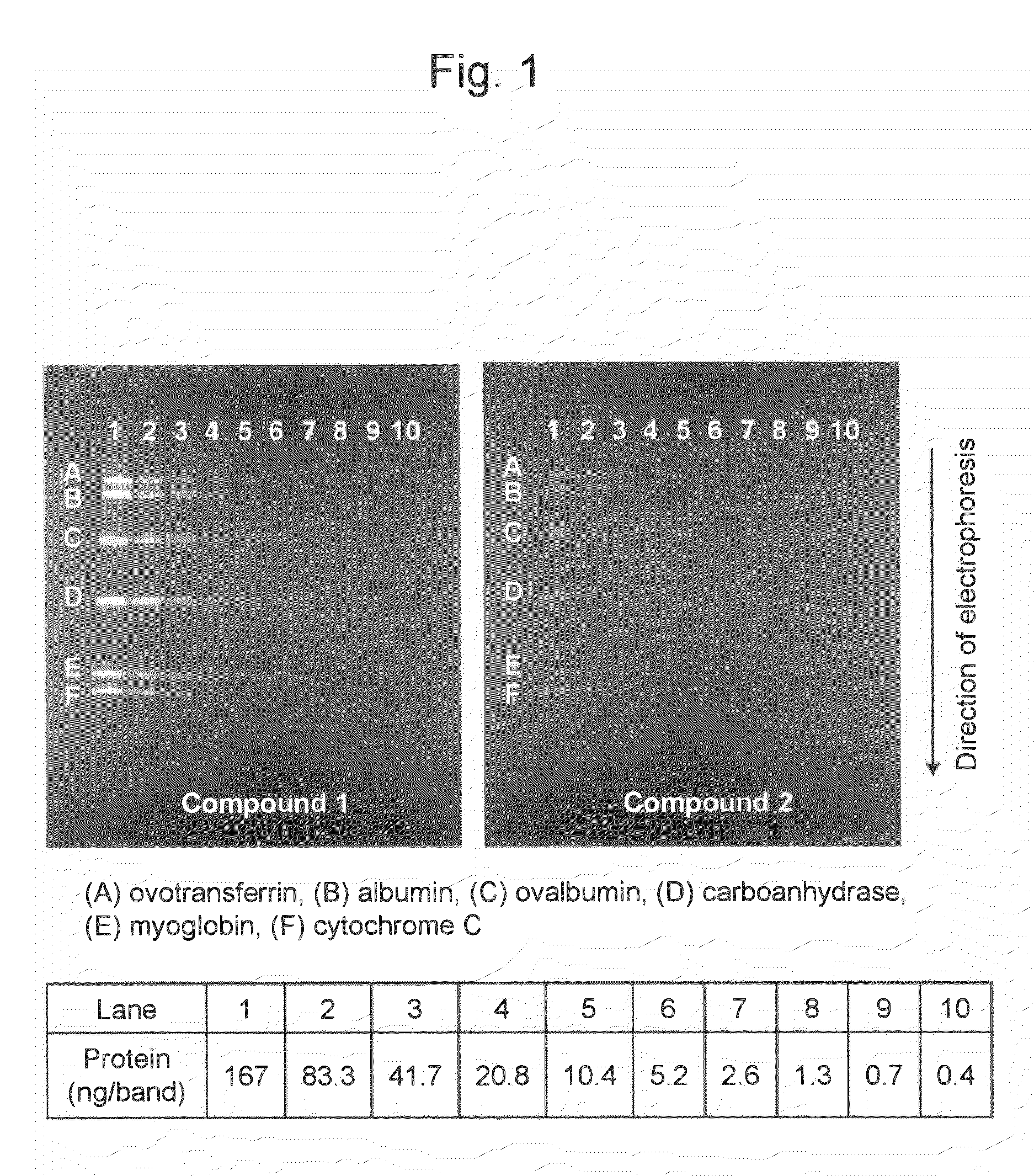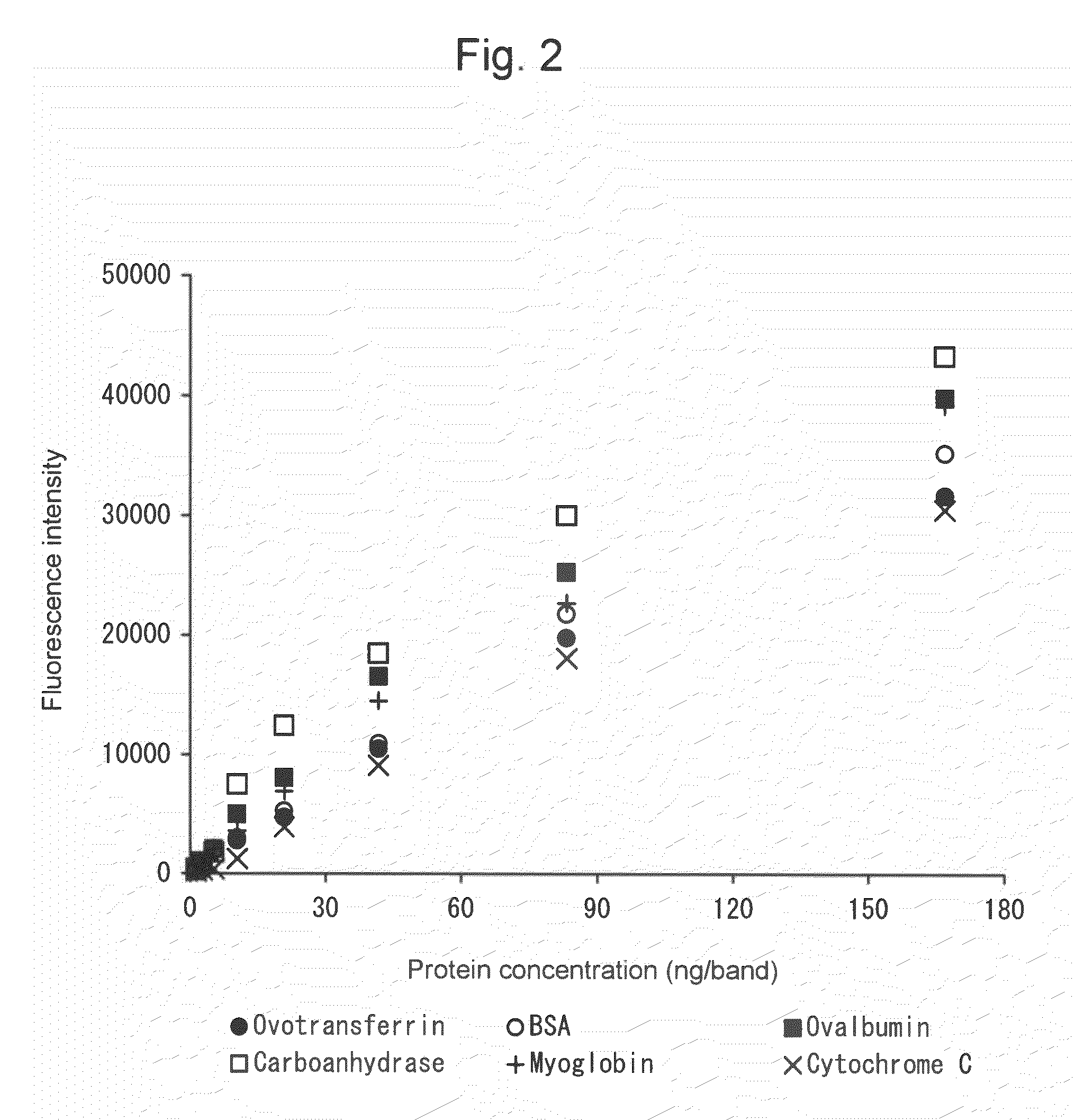Method and reagent for protein analysis
a protein and reagent technology, applied in the field of protein analysis, can solve the problems of inability to quantitatively, low detection sensitivity, and significant variation in detection sensitivity, and achieve the effect of convenient and rapid performance of highly sensitive qualitative or quantitative protein analysis
- Summary
- Abstract
- Description
- Claims
- Application Information
AI Technical Summary
Benefits of technology
Problems solved by technology
Method used
Image
Examples
example 1
(Example 1) Synthesis of compound 1 (2,2′-(1E, 1′E)-2,2′-(4-(dicyanomethylene)-4H-pyrane-2,6-diyl)bis(ethene-2,1-diyl)bis(sodium benzenesulfonate)salt)
[0047]
[0048]Sodium 2-sulfo benzaldehyde (2.42 g (11.6 mmol)) was added to a 50-mL three-neck flask and then suspended in 30 mL of ethanol:methanol=1:1 (v / v). 4-(dicyanomethylene)-2,6-dimethyl-4H-pyrane (1.0 g (5.81 mmol)) and piperidine (495 mg (5.81 mmol)) were added and then the resultant was refluxed under an argon atmosphere for 12 hours. The precipitate was collected by filtration. The thus obtained yellow powder was washed with water and then subjected to drying under reduced pressure, so that 1.43 g of a desired compound was obtained (yield: 44.5%).
[0049]ESI-MS (+): [M+Na—H]+=574.6
[0050]1H-NMR (400 MHz, DMSO-d6) σ 6.92 (2H, s), 7.20 (2H, d, J=16 Hz), 7.37-7.46 (4H, m), 7.77-7.88 (4H, m), 8.62 (2H, d, J=16 Hz).
[0051]13C-NMR (100.53 MHz, DMSO-d6) σ 56.6, 106.5, 115.5, 120.3, 127.2, 127.4, 129.0, 129.3, 132.5, 138.1, 146.4, 156.1,...
example 2
Measurement of Maximum Absorption Wavelength and Maximum Fluorescence Wavelength
[0061]Compound 1 and Compound 2 were separately dissolved in purified water at a concentration of 25 μg / mL. The absorption spectra at a wavelength ranging from 200 nm to 800 nm and the fluorescence spectra at a wavelength ranging from 450 nm to 600 nm were measured. The absorption spectra were measured using U3310 (Hitachi High-Technologies Corporation) and the fluorescence spectra were measured using RF-1500 (Shimadzu Corporation). The results are shown in Table 1.
TABLE 1Comparison of optical characteristics of compoundsMaximum absorptionMaximum fluorescencewavelengthwavelengthCompound 1293 nm516 nm (excitation: 444 nm)380 nmCompound 2388 nm511 nm (excitation: 440 nm)
example 3
Protein Detection
(1) Preparation of Samples
[0062]Two (2) mL of a stock buffer (a mixture of purified water (4.2 mL), 0.5 M Tris-hydrochloric acid buffer (pH 8.6) (1.0 mL), glycerol (0.8 mL), 100 g / L sodium dodecyl sulfate (1.6 mL), and 2-mercaptoethanol (0.4 mL)) was added to 2 mg of a commercially available molecular weight marker (Protein Standard Mixture IV; Merck & Co., Inc.). The mixture was heated in boiling water for 2 minutes and then cooled. Thirty (30) μL each of the resultant was dispensed in a 0.5-mL microtube and then cryopreserved at −80° C. until the use thereof. A sample diluent (a mixture of purified water (3.8 mL), 0.5 M Tris-hydrochloric acid buffer (pH 8.6) (1.0 mL), glycerol (0.8 mL), 100 g / L sodium dodecyl sulfate (1.6 mL), and 5 g / L bromophenol blue (0.8 mL)) was added to the thawed molecular weight marker, so that a dilution series with protein concentrations ranging from 0.4 ng / μL to 200 ng / μL was prepared.
[0063]The marker contained, in terms of mass, equal ...
PUM
| Property | Measurement | Unit |
|---|---|---|
| concentration | aaaaa | aaaaa |
| fluorescence wavelength | aaaaa | aaaaa |
| pH | aaaaa | aaaaa |
Abstract
Description
Claims
Application Information
 Login to View More
Login to View More - R&D
- Intellectual Property
- Life Sciences
- Materials
- Tech Scout
- Unparalleled Data Quality
- Higher Quality Content
- 60% Fewer Hallucinations
Browse by: Latest US Patents, China's latest patents, Technical Efficacy Thesaurus, Application Domain, Technology Topic, Popular Technical Reports.
© 2025 PatSnap. All rights reserved.Legal|Privacy policy|Modern Slavery Act Transparency Statement|Sitemap|About US| Contact US: help@patsnap.com



